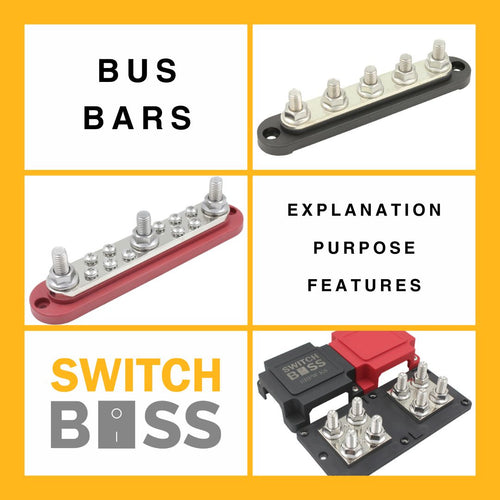Free Shipping
Free shipping Australia wide on all products
Feb 21, 2024
|
In the realm of 12V applications, particularly in caravans, boats, and vehicles, the term "bus bar" holds significant importance. Often overlooked but essential, bus bars serve as critical components in managing electrical systems on the move. In this blog, we'll delve into the intricacies of bus bars, their purpose, and the diverse features that make them an important part of mobile power management.
A bus bar, in simple terms, is a metal strip or bar used to distribute electrical power from one source to multiple devices or circuits. Think of it as a central hub where electrical connections converge and disperse, facilitating the flow of electricity throughout a system. In 12V applications, bus bars provide a convenient and efficient way to organize and manage power distribution, ensuring reliable operation of various electrical components in caravans, boats, and vehicles.
The primary purpose of a 12V bus bar is to streamline the distribution of electrical power in mobile environments. Whether in caravans, boats, or vehicles, where space and efficiency are paramount, bus bars serve as centralized points for connecting and distributing power to different devices and circuits. By consolidating electrical connections onto a single, organized platform, bus bars help minimize wiring complexity, reduce the risk of electrical faults, and ensure consistent power delivery to essential components.
Bus bars come in various configurations and designs tailored to meet the specific needs of different applications. Things to consider when selecting your bus bar include the environment, construction material, terminal size, and amp ratings.
If your bus bar is likely to be exposed to any elements it is important to select marine-grade bus bars are crafted from corrosion-resistant materials to withstand the harsh conditions of saltwater environments, ensuring longevity and reliability in marine vessels. Materials such as stainless steel provide great protection from corrosion in these environments.
Copper bus bars offer superior conductivity, minimizing energy loss and optimizing electrical efficiency. In the short distances covered in these bus bars, the energy loss can be less critical. Copper bus bars are often used in high amp and voltage power situations including city wide power distribution centres.
Terminal size options accommodate different wire gauges, providing flexibility in connection options for diverse electrical setups. Some bus bars have only one large stud size like an M8 or M10, however there are options that include two different stud sizes on the one bus bar to accommodate for multiple terminal sizes.
The bus bar shows the option to include two different sizes of terminals.
This bus bar shows only one size terminal.
Additionally, bus bars are available with different amp ratings to match the power demands of specific applications, ensuring safe and reliable operation under varying loads. The elements that impact the amp ratings include, thickness of material, type of material and the length and width of bar.
These features collectively make bus bars versatile and indispensable components in 12V power management across caravans, boats, and vehicles.
In conclusion, bus bars play a crucial role in 12V applications, serving as the backbone of electrical systems in caravans, boats, and vehicles. By providing a centralized point for power distribution, bus bars streamline wiring complexity, reduce the risk of electrical faults, and ensure consistent power delivery to essential components on the move.